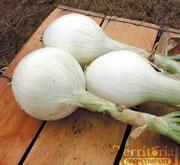From the seed catalog:
"Onions are photoperiodic plants. They regulate their stages of growth by the duration of the light/dark cycle at the particular time of year they are growing. The onion plant will make top growth until the critical light duration is reached, and bulbing begins.
Long-day varieties need to be planted as early as possible in the spring to obtain sufficient growth prior to the longest day, when they begin to bulb.
Short-day varieties need to be fall planted to obtain enough growth to make a large bulb earlier in the year when the days are shorter.
The dividing line between short-day and long-day varieties is generally accepted as 36 degrees latitude, roughly along the Kansas/Oklahoma border.
Plant long-day varieties north of this line and short-day varieties south of it. Recent breeding efforts have developed day-neutral varieties. Day-neutral and intermediate-day onions can be grown successfully anywhere."
One thing I like about this explanation is that it incorporates other elements such as the longest day of the year, which I always thought was an okay concept but didn't have anything to do with me, and latitude, which I associated with looking at the lines on a map, not growing onions.
You may think this is a boring bit of minutiae, but it explains why the onions I tried to grow a couple of years ago didn't bulb out. Someone told me I should have worked some straw into the soil to make it looser so the onions didn't have to push so hard to expand, but the long-day/short-day technical explanation makes a lot of sense to me, and now I realize it might not have been my fault my onions didn't work out.



